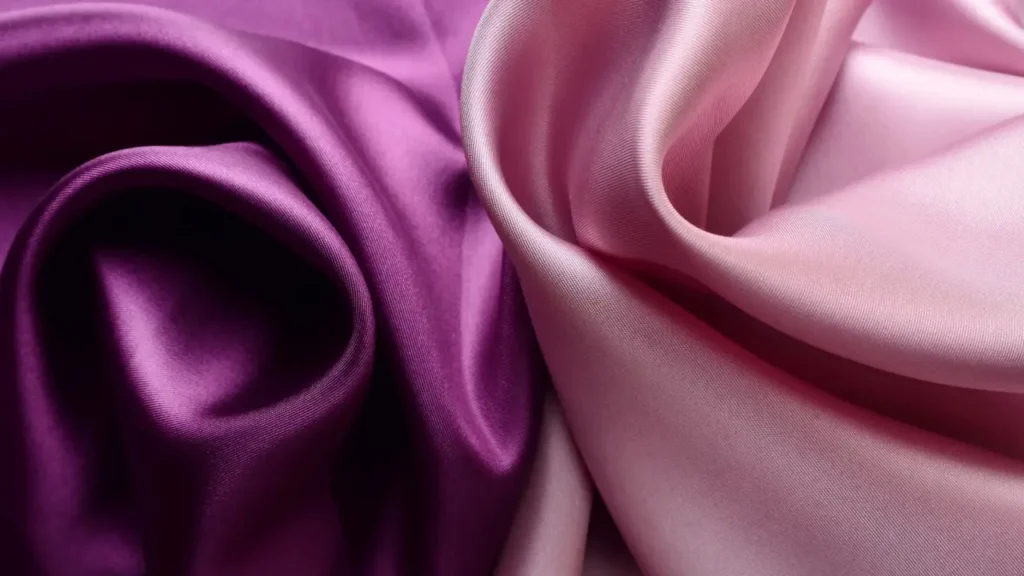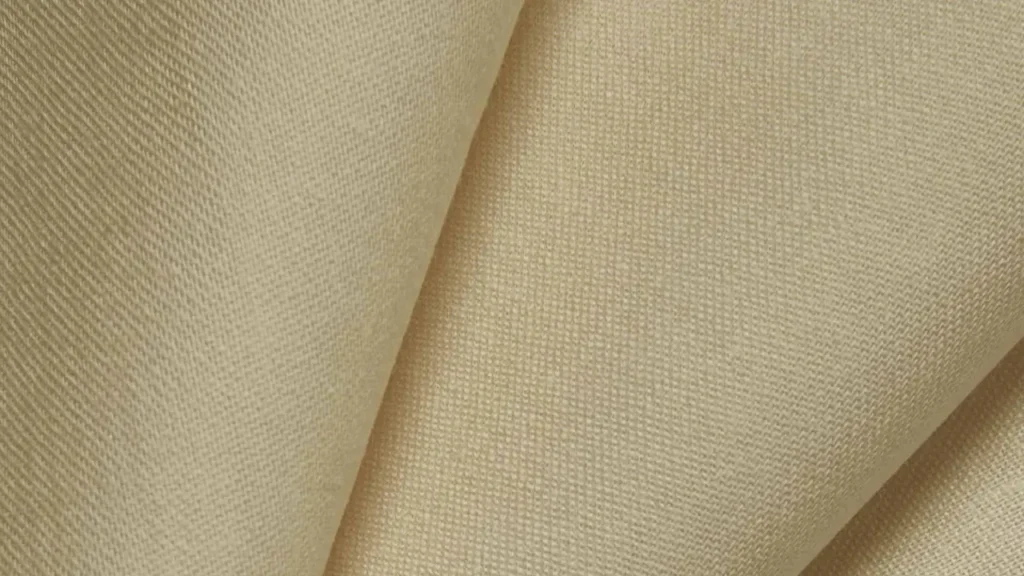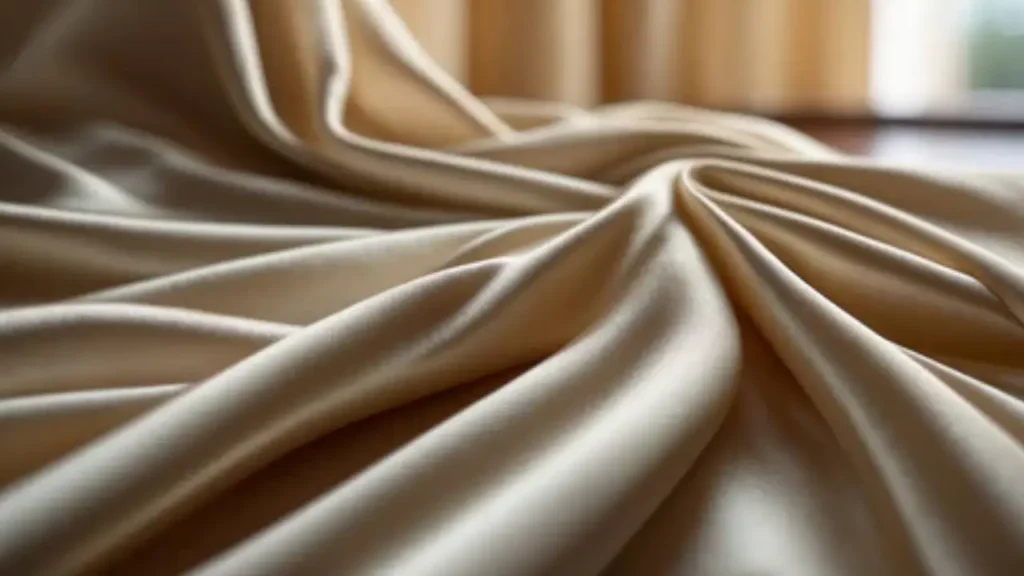Sateen fabric, renowned for its smooth, lustrous surface and luxurious feel, is a popular choice in both the fashion and home textile industries. Often mistaken for satin, sateen possesses a unique weave structure that contributes to its distinctive sheen and soft drape. Understanding the characteristics and applications of sateen can help you appreciate its elegance and make informed choices for your projects or purchases.
This ultimate guide will delve into the intricacies of sateen fabric, exploring its construction, the fibers it’s made from, and the key properties that set it apart. We will also uncover the diverse uses of sateen, from creating elegant apparel and bedding to adding a touch of sophistication to home décor. By the end of this guide, you’ll have a comprehensive understanding of what makes sateen fabric so desirable.
What is Sateen Fabric

Sateen fabric is a cotton or other non-silk fabric that is woven in a satin weave structure using spun yarns. This specific weave floats the weft yarns over several warp yarns, resulting in a smooth, lustrous surface on one side and a duller reverse. The more floats, or the more weft yarns pass over the warp yarns, the higher the sheen. This construction gives sateen a characteristically soft, often slightly heavier feel compared to plain weave cottons like percale or broadcloth.
The unique weave of sateen provides it with several desirable properties. It exhibits a subtle sheen that is often compared to silk satin, though it is typically less expensive and easier to care for. Sateen is known for its soft and smooth hand, as well as its excellent drape, allowing it to fall in graceful folds. While generally breathable due to its cotton content, its tighter weave can sometimes make it retain slightly more warmth than more open weaves. Sateen is also relatively durable and can be mercerized, a process that enhances its luster, strength, and dye uptake.
What is Sateen Fabric Made Of
Sateen fabric, known for its smooth, lustrous surface and soft drape, achieves these qualities due to its unique satin weave structure. However, the fibers used to create sateen can vary, influencing its final properties and applications. While cotton is the most common material, other fibers and blends are also utilized to produce this elegant textile.
Here’s a look at what sateen fabric is typically made of:
Blends: Sateen fabrics can also be created using blends of different fibers. For example, a cotton-polyester blend can combine the breathability of cotton with the durability and wrinkle resistance of polyester. Silk blends may be used to enhance the luxurious feel and sheen of the sateen. The specific properties of a blended sateen fabric will depend on the ratio and types of fibers used in its construction, offering a wide range of textures, drapes, and performance characteristics.
Cotton: Traditionally, and most commonly, sateen is made from 100% cotton. The cotton fibers used are often combed or carded to remove shorter fibers, resulting in longer, smoother yarns that enhance the fabric’s softness and sheen. Mercerization, a treatment involving soaking the cotton in lye and then acid, is frequently applied to cotton sateen to further improve its luster, strength, and dye uptake. Cotton sateen offers breathability, a soft hand feel, and is relatively easy to care for, making it a popular choice for bedding, apparel, and drapery.
Polyester: Sateen can also be made from polyester fibers. Polyester sateen offers increased durability, wrinkle resistance, and often a more pronounced sheen compared to cotton sateen. It is also typically more cost-effective. While it may not have the same level of breathability as cotton, polyester sateen is a popular choice for linings, some types of apparel, and home decor items where durability and a silky appearance are desired.
Rayon: Rayon, a semi-synthetic fiber made from regenerated cellulose, is another material used to produce sateen. Rayon sateen exhibits a beautiful drape and a soft, smooth hand, often with a good level of luster. It is more breathable than polyester but can be more prone to wrinkling and may require more careful washing. Rayon sateen is often used in apparel, particularly blouses and dresses, where its flowing quality is appreciated.
Sateen Fabric Properties

Sateen fabric, prized for its subtle sheen and luxurious feel, gains its unique characteristics from its specialized satin weave and the fibers used in its construction. This weave creates a fabric with a distinct personality, offering a different set of advantages compared to other common weaves. Understanding these properties is key to appreciating and utilizing sateen effectively in various applications.
Versatile Fiber Content and Weights: Sateen can be produced from various fibers, including cotton, polyester, rayon, and blends. The choice of fiber significantly influences the fabric’s breathability, wrinkle resistance, and overall performance. Cotton sateen offers good breathability, while polyester blends may enhance durability and reduce wrinkling. Sateen also comes in a range of weights, making it suitable for diverse applications from lightweight blouses to more substantial drapery and upholstery.
Smooth and Lustrous Surface: The defining feature of sateen is its smooth, almost silky surface with a noticeable sheen. This luster arises from the satin weave, where the weft yarns float over several warp yarns, minimizing the interlacing visible on the face of the fabric. This construction reflects light beautifully, giving sateen an elegant and often richer appearance compared to the matte finish of plain weave fabrics. The smoothness also contributes to a pleasant tactile experience.
Soft and Drapey Hand: Sateen fabric possesses a characteristically soft and supple hand feel, making it comfortable against the skin. The longer floats of the weft yarns in the satin weave allow the fabric to move and drape gracefully. This fluidity makes sateen ideal for garments and home textiles where a gentle fall and luxurious feel are desired. The softness can be further enhanced by the type of fiber used, with cotton sateen being particularly known for its comfort.
Good Durability and Stability: Despite its smooth and elegant appearance, sateen is generally a durable fabric, especially when made from high-quality cotton or polyester. The tight weave contributes to its resilience, making it suitable for items that will see regular use. However, the longer floats in the weave can make it slightly more prone to snagging compared to tightly woven plain weaves. Proper care can help maintain its integrity and prolong its lifespan.
What is Sateen Fabric Used For

Bedding: Sateen’s smooth and soft texture, combined with the breathability of cotton (if made from cotton), makes it a popular choice for luxurious bed linens such as sheets, pillowcases, and duvet covers. The subtle sheen adds an elegant touch to the bedroom.
Apparel: The elegant drape and soft hand of sateen make it suitable for various clothing items. It’s often used for blouses, dresses, skirts, and even linings in jackets. Stretch sateen, with added spandex, is excellent for form-fitting garments, offering both comfort and a smooth silhouette.
Home Decor: Beyond bedding, sateen finds its place in other home decor applications. Its ability to drape beautifully makes it a good option for curtains and draperies, adding a touch of sophistication to interiors. It can also be used for decorative pillows and throws.
Linings: The smooth surface of sateen makes it an excellent choice for garment linings. It allows clothing to slide on and off easily and adds a comfortable layer against the skin. Polyester sateen is particularly favored for linings due to its durability and smooth feel.
Cotton Sateen Fabric vs Cotton

While both cotton sateen and regular cotton are derived from the same natural fiber, their distinct weaving processes result in fabrics with noticeably different properties and aesthetics. Understanding these key differences is crucial when selecting the right material for your project, whether it’s for clothing, bedding, or home decor.
The choice between the matte, often crisper feel of regular cotton and the smooth, lustrous drape of cotton sateen can significantly impact the final outcome in terms of both look and feel.
Durability and Breathability: Regular cotton is known for its good durability, especially in tighter weaves. It also offers excellent breathability, making it comfortable for various climates. Cotton sateen, while still durable, can be slightly more susceptible to snagging or pilling due to the longer floats of the weft yarns on the surface. However, like regular cotton, it retains good breathability, especially in 100% cotton varieties.
Weave Structure: Regular cotton typically features a plain weave, where the warp and weft threads interlace in a simple over-one, under-one pattern. This results in a fabric with a balanced appearance and a matte finish. In contrast, cotton sateen is woven with a satin weave, characterized by weft yarns floating over multiple warp yarns before going under. This creates a smoother surface with a noticeable luster or sheen on one side.
Surface Feel and Appearance: Due to its plain weave, regular cotton often has a slightly more textured or crisp hand feel and a matte appearance. It can range from smooth (like broadcloth) to slightly rougher (like canvas), depending on the specific weave and yarn. Cotton sateen, thanks to its satin weave, boasts a remarkably smooth and often silky hand feel with a subtle to moderate sheen, giving it a more luxurious and elegant look compared to regular cotton.
Drape and Wrinkle Resistance: Regular cotton’s drape can vary widely depending on its weight and weave; some are crisp and structured, while others are more fluid. It generally tends to wrinkle more easily than some synthetic fabrics. Cotton sateen typically exhibits a softer and more fluid drape due to the way it’s woven. While it is still prone to wrinkling because it’s cotton, some may find it wrinkles slightly less dramatically than certain plain weave cottons.
Sateen Fabric vs Satin

While both sateen and satin are known for their smooth, lustrous surfaces, they differ in their fiber composition and weave structure, leading to distinct properties and applications. Understanding these differences will help you choose the right fabric for your desired project, whether it’s for luxurious bedding or elegant apparel.
Fiber Content
Satin is traditionally made from long filament fibers like silk, although more affordable options often utilize polyester, nylon, or rayon. These long, continuous fibers contribute to satin’s characteristic high sheen and fluid drape. True satin was historically exclusively silk, and some purists still consider silk the only genuine form of satin.
Sateen, on the other hand, is typically made from spun yarns, which are shorter fibers twisted together. Common fibers used for sateen include cotton, rayon, and sometimes polyester. The use of these shorter staple fibers results in a fabric that is generally softer and often more durable than many satins, particularly those made from synthetic filaments.
Weave Structure
Both satin and sateen employ a satin weave, which is characterized by warp or weft yarns floating over multiple yarns of the opposite set before interlacing. This creates the smooth, lustrous face of the fabric. However, the specific direction of the floats differs.
Satin is typically a warp-faced weave, meaning the warp (vertical) yarns dominate the face of the fabric, creating its signature high gloss. Sateen is a weft-faced weave, where the weft (horizontal) yarns have more coverage on the fabric’s surface. This results in a softer sheen compared to satin. The different yarn emphasis in the weave contributes to the distinct look and feel of each fabric.
Sheen and Texture
Satin is known for its high-gloss finish, which reflects light intensely, giving it a very shiny and often glamorous appearance. Its texture is typically very smooth and can be quite slippery to the touch due to the long, uninterrupted floats of the warp yarns.
Sateen has a more subdued and subtle luster compared to satin. While it still possesses a sheen, it’s often described as a soft glow rather than a bright shine. The texture of sateen is also smooth but tends to be less slippery and often feels more substantial and comfortable due to the spun yarns, especially when made from cotton.
Durability and Care
Satin, particularly when made from silk, can be delicate and prone to snags and damage due to its long, exposed filaments. It often requires hand washing or dry cleaning to maintain its appearance and integrity. Synthetic satins are generally more durable but can still be susceptible to damage from heat and abrasion.
Sateen, especially cotton sateen, is generally more durable and easier to care for. It is often machine washable and can withstand more regular use, making it a popular choice for bedding and everyday wear. The shorter spun fibers contribute to its increased resilience compared to the continuous filaments of many satins.
Common Applications
Satin, with its luxurious sheen and fluid drape, is frequently used for formal wear, lingerie, scarves, and decorative accents where a glamorous look is desired. Its slippery texture and high shine make it ideal for garments that flow and catch the light.
Sateen, with its softer sheen and more durable nature, is commonly used for bedding (sheets, duvet covers), drapery, and apparel that requires a smooth, comfortable feel with a touch of elegance, but with better wearability than traditional satin. Its versatility makes it suitable for both practical and decorative purposes.
Is Cotton Sateen Fabric Shiny
Yes, cotton sateen fabric does have a noticeable shine, although it’s generally described as a subtle or moderate luster rather than the high gloss of silk satin. This sheen is a direct result of the satin weave used to construct the fabric.
In a sateen weave, the weft (horizontal) yarns float over several warp (vertical) yarns before going under just one. These “floats” on the surface of the fabric reflect light more evenly, creating the characteristic sheen. While the shine is present, it’s often considered more understated and sophisticated compared to the very slippery and highly reflective nature of true satin, which is typically made from continuous filament fibers like silk or polyester.
Is Sateen Fabric Stretchy
While sateen fabric itself isn’t inherently stretchy due to its weave structure, it can be made stretchy by incorporating elastic fibers like spandex or Lycra into its construction. When these stretchable fibers are blended with the primary fiber (most commonly cotton), the resulting fabric gains the ability to stretch and recover its shape. This “stretch sateen” offers both the smooth, lustrous appearance and soft feel of traditional sateen along with added flexibility and comfort, making it popular for form-fitting garments.
Therefore, whether or not a sateen fabric is stretchy depends entirely on its fiber composition. A 100% cotton sateen will typically have very little to no stretch, relying on the weave for its drape. However, if the sateen fabric includes a percentage of elastic fibers, it will possess varying degrees of stretch, making it suitable for a wider range of applications where movement and comfort are desired. Always check the fabric composition to determine if a sateen has stretch properties.
Conclusion
In conclusion, sateen fabric distinguishes itself through its unique weave, which imparts a signature smooth feel and subtle sheen, setting it apart from other cotton weaves. Its luxurious drape and soft touch make it a favored choice for applications where comfort and elegance are paramount, such as bedding and high-quality apparel. Understanding its properties allows for informed decisions when selecting textiles for various projects.
The versatility of sateen extends beyond its aesthetic appeal. While often associated with a touch of luxury, it also offers the breathability of cotton, making it a practical choice for everyday use. Proper care ensures the longevity of its smooth texture and lustrous appearance, allowing you to enjoy its refined qualities for years to come. Whether for creating comfortable bedding or stylish garments, sateen provides a sophisticated touch.
Elevate your textile offerings with the smooth elegance of sateen. Fanda Fabrics provides a wide selection of high-quality wholesale sateen fabric in various colors and compositions to meet your bulk needs. Contact us today to explore our sateen collection and offer your customers a touch of luxury and comfort!
